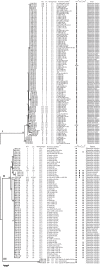Prevalence, Potential Virulence, and Genetic Diversity of Listeria monocytogenes Isolates From Edible Mushrooms in Chinese Markets
- PMID: 30100901
- PMCID: PMC6072871
- DOI: 10.3389/fmicb.2018.01711
Prevalence, Potential Virulence, and Genetic Diversity of Listeria monocytogenes Isolates From Edible Mushrooms in Chinese Markets
Abstract
Listeria monocytogenes, an intracellular foodborne pathogen, is capable of causing listeriosis, such as meningitis, meningoencephalitis, and abortion. In recent years, the occurrence of Listeria monocytogenes in edible mushroom products has been reported in several countries. There are no guidelines for qualitative and quantitative detection of L. monocytogenes in mushroom products in China. Therefore, this study aimed to investigate the prevalence and contamination level of L. monocytogenes in edible mushrooms in Chinese markets and to determine the antibiotic resistance and sequence types (STs) of these isolates to provide data for risk assessments. Approximately 21.20% (141/665) of edible mushroom samples were positive for L. monocytogenes, while 57.44% (81/141) of positive samples contained contamination levels of less than 10 MPN/g. The 180 isolates derived from positive samples belonged to serogroup I.1 (1/2a-3a, n = 111), followed by serogroup II.2 (1/2b-3b-7, n = 66), and serogroup III (4a-4c, n = 3). Antibiotic susceptibility testing showed that over 95% of L. monocytogenes isolates were resistant to penicillin, ampicillin, oxacillin, and clindamycin, while over 90% were susceptible to 16 antibiotic agents, the mechanisms of resistance remain to be elucidated. According to multilocus sequencing typing, the 180 isolates represented 21 STs, one of which was identified for the first time. Interestingly, ST8 and ST87 were predominant in edible mushroom products, indicating that specific STs may have distinct ecological niches. Potential virulence profiles showed that most of the isolates contained full-length inlA genes, with novel premature stop codons found in isolate 2035-1LM (position 1380, TGG→TGA) and 3419-1LM (position 1474, CAG→TAG). Five isolates belonging to serogroup II.2 carried the llsX gene from Listeria pathogenicity island (LIPI)-3, present in ST224, ST3, and ST619; 53 (29.44%) harbored the ptsA gene from LIPI-4, presenting in ST3, ST5, ST87, ST310, ST1166, and ST619. Five potential hypervirulent isolates carrying all three of these virulence factors were identified, suggesting edible mushrooms may serve as possible transmission routes of potential hypervirulent L. monocytogenes, which may be of great public health concern to consumers. Based on our findings, the exploration of novel approaches to control L. monocytogenes contamination is necessary to ensure the microbiological safety of edible mushroom products.
Keywords: Listeria monocytogenes; antibiotic resistance profiles; edible mushrooms; multilocus sequence typing; serotypes; virulence profiles.
Figures





References
LinkOut - more resources
Full Text Sources
Other Literature Sources

